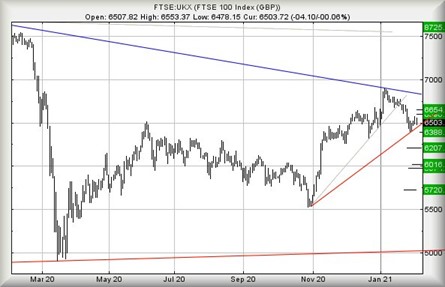FTSE 100: why is the index running scared?
Our columnist asks what’s next for the market, and for Royal Dutch Shell.
5th February 2021 08:42
by Alistair Strang from Trends and Targets
Our columnist asks what’s next for the market, and for Royal Dutch Shell.

FTSE for Friday (FTSE:UKX) and Royal Dutch Shell (LSE:RDSB)
The FTSE 100 appears to be exhibiting signs of terror.
The market spent much of January in a slow and steady decline. Conventional logic suggests weakness below 6,430 risks driving reversal to an initial 6,207 points, with secondary, if broken, around the 6,016 level.
With the index presently trading around 6,503 points, very little work is required to present a new ‘lower low’, along with the prospect of some trouble. The market requires to move above 6,850 to negate such a scenario.
Near term, movements above 6,554 have interesting potentials, allowing movement to an initial 6,598 with secondary, if exceeded, calculating at 6,654 points. If triggered, the tightest stop level looks wide at 6,500 points.
The alternate (and visually more likely) near-term scenario allows traffic below 6,448 to spell trouble. A triggering movement like this calculates with the potential of reversal to an initial 6,411 with secondary, if broken, down at 6,388, along with a (almost certain) rebound.

We've been anticipating an outbreak of reversals due to companies releasing some horrific income levels for last year. The most recent, Royal Dutch Shell, proved quite sneaky.
They announced record losses, choosing to balance this with an (astounding) announcement of a dividend increase.
Essentially, they were saying "yes, 2020 was dire but we're thinking of the future now". As a result, instead of a 20% hammering, the share price reversed by just 2% and resides in an area where we've even hope for some sort of bounce.
But if it closes below 1,297p things risk going wrong rather fast, as there's a real risk of the price falling 20% from current levels.
It shall be curious if this pattern continues as further companies issue results. It would certainly scupper our belief the market faces a thrashing thanks to lack of income from 2020.
Source: Trends and Targets. Past performance is not a guide to future performance
Alistair Strang has led high-profile and "top secret" software projects since the late 1970s and won the original John Logie Baird Award for inventors and innovators. After the financial crash, he wanted to know "how it worked" with a view to mimicking existing trading formulas and predicting what was coming next. His results speak for themselves as he continually refines the methodology.
Alistair Strang is a freelance contributor and not a direct employee of interactive investor. All correspondence is with Alistair Strang, who for these purposes is deemed a third-party supplier. Buying, selling and investing in shares is not without risk. Market and company movement will affect your performance and you may get back less than you invest. Neither Alistair Strang or interactive investor will be responsible for any losses that may be incurred as a result of following a trading idea.
These articles are provided for information purposes only. Occasionally, an opinion about whether to buy or sell a specific investment may be provided by third parties. The content is not intended to be a personal recommendation to buy or sell any financial instrument or product, or to adopt any investment strategy as it is not provided based on an assessment of your investing knowledge and experience, your financial situation or your investment objectives. The value of your investments, and the income derived from them, may go down as well as up. You may not get back all the money that you invest. The investments referred to in this article may not be suitable for all investors, and if in doubt, an investor should seek advice from a qualified investment adviser.
Full performance can be found on the company or index summary page on the interactive investor website. Simply click on the company's or index name highlighted in the article.